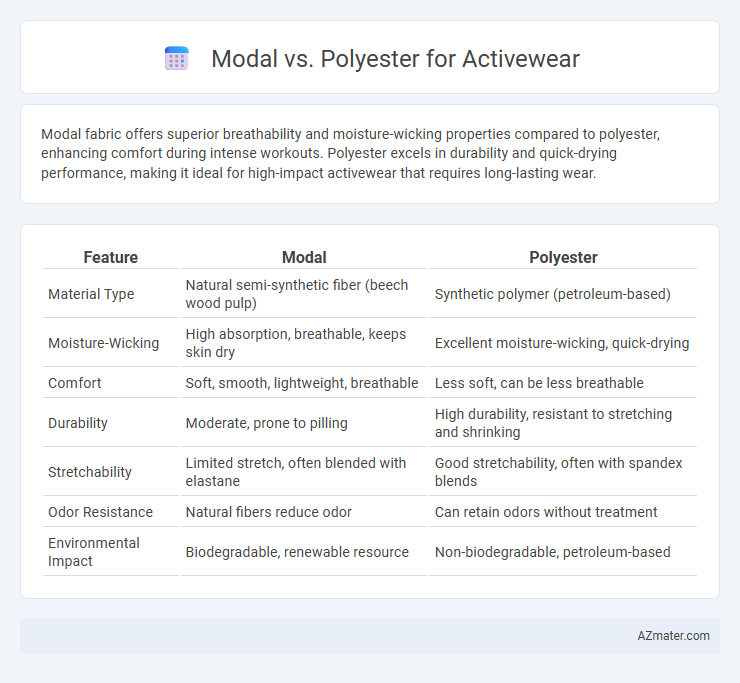Modal fabric offers superior breathability and moisture-wicking properties compared to polyester, enhancing comfort during intense workouts. Polyester excels in durability and quick-drying performance, making it ideal for high-impact activewear that requires long-lasting wear.
Table of Comparison
| Feature | Modal | Polyester |
|---|---|---|
| Material Type | Natural semi-synthetic fiber (beech wood pulp) | Synthetic polymer (petroleum-based) |
| Moisture-Wicking | High absorption, breathable, keeps skin dry | Excellent moisture-wicking, quick-drying |
| Comfort | Soft, smooth, lightweight, breathable | Less soft, can be less breathable |
| Durability | Moderate, prone to pilling | High durability, resistant to stretching and shrinking |
| Stretchability | Limited stretch, often blended with elastane | Good stretchability, often with spandex blends |
| Odor Resistance | Natural fibers reduce odor | Can retain odors without treatment |
| Environmental Impact | Biodegradable, renewable resource | Non-biodegradable, petroleum-based |
Introduction to Modal and Polyester in Activewear
Modal and polyester are two popular fabrics used in activewear, each offering distinct benefits for performance and comfort. Modal, a semi-synthetic cellulose fiber derived from beech trees, is known for its exceptional softness, breathability, and moisture-wicking properties, making it ideal for lightweight and comfortable workout clothing. Polyester, a synthetic polymer fiber, provides durability, quick-drying capability, and excellent shape retention, often incorporated in activewear for high-intensity activities and longer-lasting apparel.
Fabric Composition: Modal vs Polyester
Modal fabric is a semi-synthetic fiber made from beech tree pulp, offering natural breathability and moisture-wicking properties ideal for activewear. Polyester, a fully synthetic polymer derived from petroleum, provides superior durability, stretch, and quick-drying capabilities essential for high-performance sports clothing. Choosing between Modal and Polyester depends on the desired balance of eco-friendliness, softness, and moisture management in activewear fabric composition.
Moisture-Wicking Capabilities
Modal and polyester both offer distinct moisture-wicking qualities essential for activewear performance. Modal, made from beech tree pulp, provides superior breathability and softness but tends to absorb more moisture, leading to slower drying times. Polyester, a synthetic fiber, excels in moisture-wicking by efficiently pulling sweat away from the skin and drying quickly, making it the preferred choice for high-intensity workouts.
Breathability and Comfort
Modal fabric boasts superior breathability due to its natural cellulose fibers that wick moisture efficiently, keeping the skin dry during intense workouts. Polyester, while durable and moisture-resistant, tends to trap heat and cause sweat buildup, reducing overall comfort. For activewear, modal offers enhanced softness and a cooler feel, making it ideal for activities prioritizing comfort and ventilation.
Durability and Longevity
Modal offers moderate durability with a soft, breathable texture that can withstand regular wear but may weaken faster under intense physical activity compared to polyester. Polyester exhibits superior longevity due to its high resistance to abrasion, moisture, and UV exposure, making it ideal for rigorous activewear requiring frequent washing and sustained performance. Choosing polyester ensures prolonged durability and shape retention, while modal provides comfort with slightly reduced wear resistance.
Stretch and Flexibility
Modal fabric offers superior stretch and flexibility compared to polyester, making it ideal for activewear that requires ease of movement. Its natural fibers provide a soft, breathable feel while maintaining shape and resilience during physical activities. Polyester, while durable and moisture-wicking, tends to be less flexible and can restrict movement compared to the elasticity found in modal blends.
Sustainability and Eco-Friendliness
Modal fabric, derived from sustainably sourced beech trees, offers biodegradability and low environmental impact due to its closed-loop production process, making it a highly eco-friendly choice for activewear. Polyester, primarily made from petroleum-based synthetic fibers, poses sustainability challenges including high energy consumption during manufacturing and microplastic pollution from washing. Innovations in recycled polyester production help reduce environmental footprint, but modal remains superior in biodegradability and renewable resource use for sustainable activewear.
Care and Maintenance Requirements
Modal activewear requires gentle washing in cold water and air drying to maintain its softness and prevent shrinkage, as this semi-synthetic fiber is sensitive to high heat and harsh detergents. Polyester activewear offers greater durability and easy care, tolerating machine washing and drying without significant loss of shape or color, making it ideal for frequent use and high-intensity workouts. Proper care of Modal extends its lifespan but demands more attention, whereas polyester provides low-maintenance performance suitable for athletes seeking convenience.
Cost Comparison
Modal activewear generally costs more than polyester due to its natural origin and eco-friendly production process, which increases manufacturing expenses. Polyester, a synthetic fiber derived from petroleum, remains a more affordable option for activewear because of its mass production and scalability. Brands often choose polyester when prioritizing cost-efficiency without compromising durability and moisture-wicking properties.
Best Applications for Modal and Polyester in Activewear
Modal offers exceptional softness, moisture-wicking properties, and breathability, making it ideal for activewear items like yoga pants and lightweight tops that require comfort and skin-friendliness. Polyester excels in durability, stretch recovery, and quick-drying capabilities, rendering it suitable for high-intensity sportswear such as running shorts, compression garments, and performance tees. Combining modal and polyester often results in activewear that balances comfort with functionality, catering to diverse workout needs.

Infographic: Modal vs Polyester for Activewear
 azmater.com
azmater.com